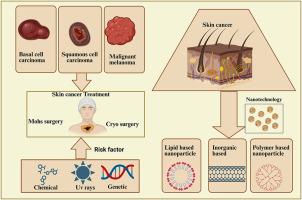局部纳米颗粒治疗皮肤癌:目前的关注和挑战
IF 4.9
3区 医学
Q1 PHARMACOLOGY & PHARMACY
Journal of Drug Delivery Science and Technology
Pub Date : 2025-09-25
DOI:10.1016/j.jddst.2025.107566
引用次数: 0
摘要
皮肤癌(SC),通常被称为黑色素瘤,已成为人类主要的恶性肿瘤。皮肤是一种广泛使用的局部和全身给药途径,呈现出基于纳米颗粒的给药潜力。SC治疗因疾病分期而异。许多技术,包括放疗、手术和化疗,现在被用于诊断SC。然而,目前治疗方法的局限性在于,研究人员正在寻找一种改进的输送系统,以获得更好的结果。目前正在开发各种药物方法,从纳米技术到物理增强技术,以改善针对特定靶向肿瘤的药物输送系统。局部给药方法是将纳米颗粒递送到真皮层的最著名的策略。角质层是皮肤的最上层,是皮肤的重要屏障。为了克服这些问题,纳米技术通过在低毒性水平下提供有效的药物递送,在治疗SC方面的应用引起了人们越来越大的兴趣。局部给药具有许多优点,包括避免快速通过肝脏代谢,减少全身副作用和无侵入性,因此提供了有效的给药。这篇全面的综述强调了各种纳米颗粒技术在系统和局部治疗皮肤癌方面的最新发展,并提供了相关专利和临床试验结果的总结。本文章由计算机程序翻译,如有差异,请以英文原文为准。

Topical nanoparticles for the treatment of skin cancer: Present concerns and challenges
Skin cancer (SC), commonly known as melanoma, has become a predominant malignancy among humans. The skin is a widely utilized pathway for administering both local and systemic drugs, presenting the potential for nanoparticle-based delivery. SC treatment varies based on the disease stage. Many techniques, including radiotherapy, Surgery, and chemotherapy, are now being used to diagnose SC. However, the limitation of the current treatment approach is that researchers are searching for an improved delivery system to achieve better outcomes. Various pharmaceutical approaches, from nanotechnology to physical enhancement techniques, are presently being developed to improve medication delivery systems for specific targeted tumors. The topical method of drug delivery is the most well-known strategy for delivering nanoparticles to the dermal layer. The stratum corneum, which forms the uppermost layer, represents a significant barrier to the skin. To overcome these problems, nanotechnology has sparked a growing interest in its application in treating SC by offering efficient drug delivery at lower toxicity levels. Topical delivery of drugs offers effective administration due to their numerous benefits, including avoiding fast-pass hepatic metabolism, reducing systemic side effects, and non-invasiveness. This comprehensive review highlights the latest developments in various nanoparticle technologies for treating skin cancer both systemically and topically, as well as provides a summary of relevant patents and clinical trial outcomes.
求助全文
通过发布文献求助,成功后即可免费获取论文全文。
去求助
来源期刊
CiteScore
8.00
自引率
8.00%
发文量
879
审稿时长
94 days
期刊介绍:
The Journal of Drug Delivery Science and Technology is an international journal devoted to drug delivery and pharmaceutical technology. The journal covers all innovative aspects of all pharmaceutical dosage forms and the most advanced research on controlled release, bioavailability and drug absorption, nanomedicines, gene delivery, tissue engineering, etc. Hot topics, related to manufacturing processes and quality control, are also welcomed.

 求助内容:
求助内容: 应助结果提醒方式:
应助结果提醒方式:


